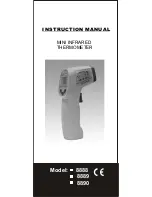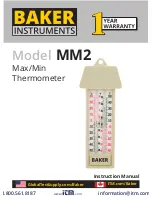
Symbol Descriptions
The CE mark and Notified
Body Registration Numbers,
the requirement of Annex II
from Medical Device Directive
93/42/EEC are met.
Indicates this device is subject to the
Waste Electrical and Electronic.
Equipment Directive in the European
Union. To protect the environment,
dispose of useless device at
appropriate collection sites according
to national or local regulations.
Do not reuse
Caution
Please read the instructions for use
Paper Recycling
Manufacturer
BF type applied part
Battery Recycling
Authorized representative in
the European community
Guidance and manufacturer’s declaration – electromagnetic emissions
The TH7xy series is intended for use in the electromagnetic environment specified below. The customer or the user of the
TH7xy series should assure that it is used in such an environment.
Emissions test
Compliance
Electromagnetic environment
–
guidance
RF emissions
CISPR 11
Group 1
The TH7xy series uses RF energy only for its internal function. Therefore, its
RF emissions are very low and are not likely to cause any interference in
nearby electronic equipment.
RF emissions
CISPR 11
Class B
Harmonic emissions
IEC 61000-3-2
Not applicable
Voltage fluctuations/
flicker emissions
IEC 61000-3-3
Not applicable
The TH7xy series is suitable for use in all establishments, including domestic
establishments and those directly connected to the public low-voltage power
supply network that supplies buildings used for domestic purposes.
Guidance and manufacturer’s declaration – electromagnetic immunity
The TH7xy series is intended for use in the electromagnetic environment specified below. The customer or the user of the
TH7xy series should assure that it is used in such an environment.
Immunity test
IEC 60601 test
level
Compliance level
Electromagnetic environment
–
guidance
Conducted RF
IEC 61000-4-6
Radiated RF
IEC 61000-4-3
3 Vrms
150 kHz to 80 MHz
3 V/m
80 MHz to 2,5 GHz
Not applicable
3 V/m
Portable and mobile RF communications equipment should be
used no closer to any part of the TH7xy series, including
cables, than the recommended separation distance calculated
from the equation applicable to the frequency of the
transmitter.
Recommended separation distance
d =
1,2
d =
1,2
80 MHz to 800 MHz
d =
2,3
800 MHz to 2,5 GHz
where
P
is the maximum output power rating of the transmitter
in watts (W) according to the transmitter manufacturer and
d
is
the recommended separation distance in meters (m).
Field strengths from fixed RF transmitters, as determined by
an electromagnetic site survey, a should be less than the
compliance level in each frequency range b.
Interference may occur in the vicinity of equipment
marked with the following symbol:
NOTE 1 At 80 MHz and 800 MHz, the higher frequency range applies.
NOTE 2 These guidelines may not apply in all situations. Electromagnetic propagation is affected by absorption
and reflection from structures, objects and people.
a. Field strengths from fixed transmitters, such as base stations for radio (cellular/cordless) telephones and land mobile radios,
amateur radio, AM and FM radio broadcast and TV broadcast cannot be predicted theoretically with accuracy. To assess the
electromagnetic environment due to fixed RF transmitters, an electromagnetic site survey should be considered. If the
measured field strength in the location in which the TH7xy series is used exceeds the applicable RF compliance level
above, the TH7xy series should be observed to verify normal operation. If abnormal performance is observed, additional
measures may be necessary, such as reorienting or relocating the TH7xy series.
b. Over the frequency range 150 kHz to 80 MHz, field strengths should be less than 3 V/m.
Guidance and manufacturer’s declaration – electromagnetic immunity
The TH7xy series is intended for use in the electromagnetic environment specified below. The customer or the user of the
TH7xy series should assure that it is used in such an environment.
Immunity test
IEC 60601 test level
Compliance level
Electromagnetic environment
–
guidance
Electrostatic
discharge (ESD)
IEC 61000-4-2
6 kV contact
8 kV air
6 kV contact
8 kV air
Floors should be wood, concrete or ceramic tile.
If floors are covered with synthetic material, the
relative humidity should be at least 30 %.
Electrical fast
transient/burst
IEC 61000-4-4
2 kV for power supply
lines
1 kV for input/output lines
Not applicable
Mains power quality should be that of a
typical commercial or hospital environment.
Surge
IEC 61000-4-5
1 kV line(s) to line(s)
2 kV line(s) to earth
Not applicable
Mains power quality should be that of a
typical commercial or hospital environment.
interruptions and
voltage variations
on power supply
input lines
IEC 61000-4-11
<5 % UT
(>95 % dip in UT)
for 0,5 cycle
40 % UT
(60 % dip in UT)
for 5 cycles
70 % UT
(30 % dip in UT)
for 25 cycles
<5 % UT
(>95 % dip in UT)
for 5 sec
Not applicable
Mains power quality should be that of a
typical commercial or hospital environment.
If the user of the TH7xy series requires
continued operation during power mains
interruptions, it is recommended that the
TH7xy series be powered from an
uninterruptible power supply or a battery.
Power frequency
(50/60 Hz)
magnetic field
IEC 61000-4-8
3 A/m
3 A/m
Power frequency magnetic fields should be
at levels characteristic of a typical location
in a typical commercial or hospital
environment.
NOTE UT is the a.c. mains voltage prior to application of the test level.
Recommended separation distances between
portable and mobile RF communications equipment and the ME EQUIPMENT or ME SYSTEM
The TH7xy series is intended for use in an electromagnetic environment in which radiated RF disturbances are controlled. The
customer or the user of the TH7xy series can help prevent electromagnetic interference by maintaining a minimum distance between
portable and mobile RF communications equipment (transmitters) and the TH7xy series as recommended below, according to the
maximum output power of the communications equipment.
Separation distance according to frequency of transmitter
m
Rated maximum output
power of transmitter
W
150 kHz to 80 MHz
d =
1,2
80 MHz to 800 MHz
d =
1,2
800 MHz to 2,5 GHz
d =
2,3
0,01
0,12
0,12
0,23
0,1
0,38
0,38
0,73
1
1,2
1,2
2,3
10
3,8
3,8
7,3
100
12
12
23
For transmitters rated at a maximum output power not listed above, the recommended separation distance
d
in meters (m) can be
estimated using the equation applicable to the frequency of the transmitter, where
P
is the maximum output power rating of the
transmitter in watts (W) according to the transmitter manufacturer.
NOTE 1 At 80 MHz and 800 MHz, the separation distance for the higher frequency range applies.
NOTE 2 These guidelines may not apply in all situations. Electromagnetic propagation is affected by absorption and reflection from
structures, objects and people.





















